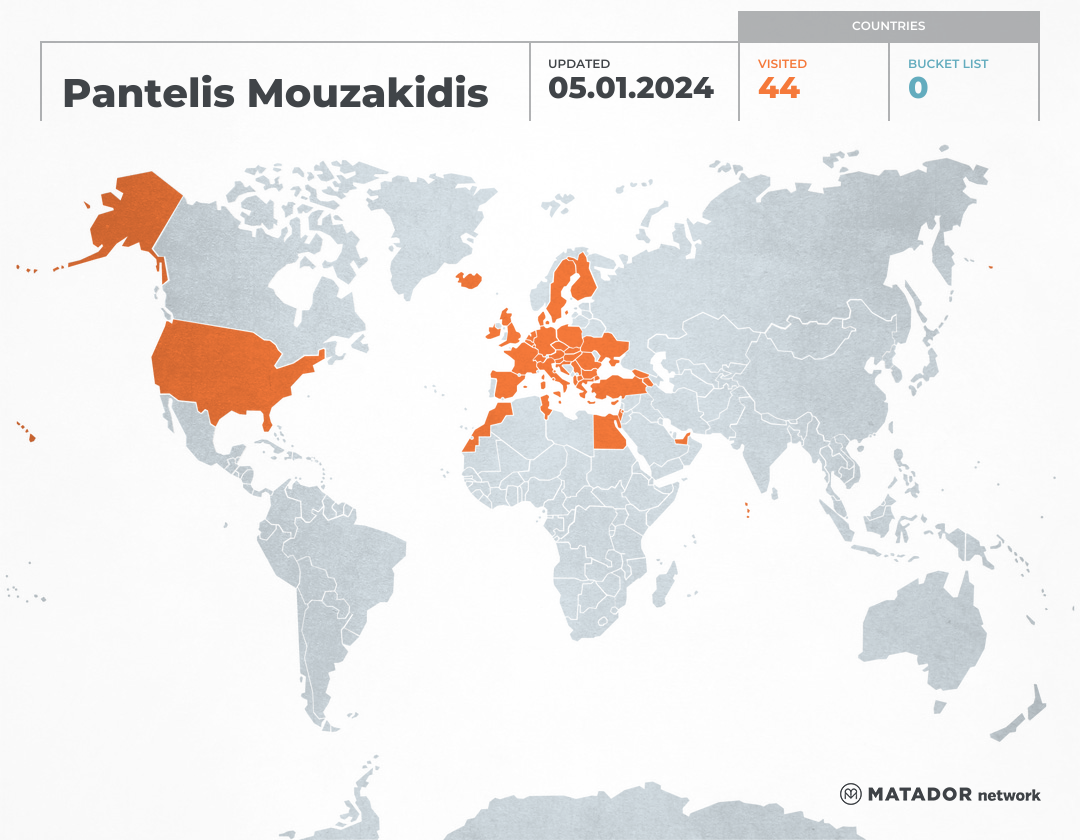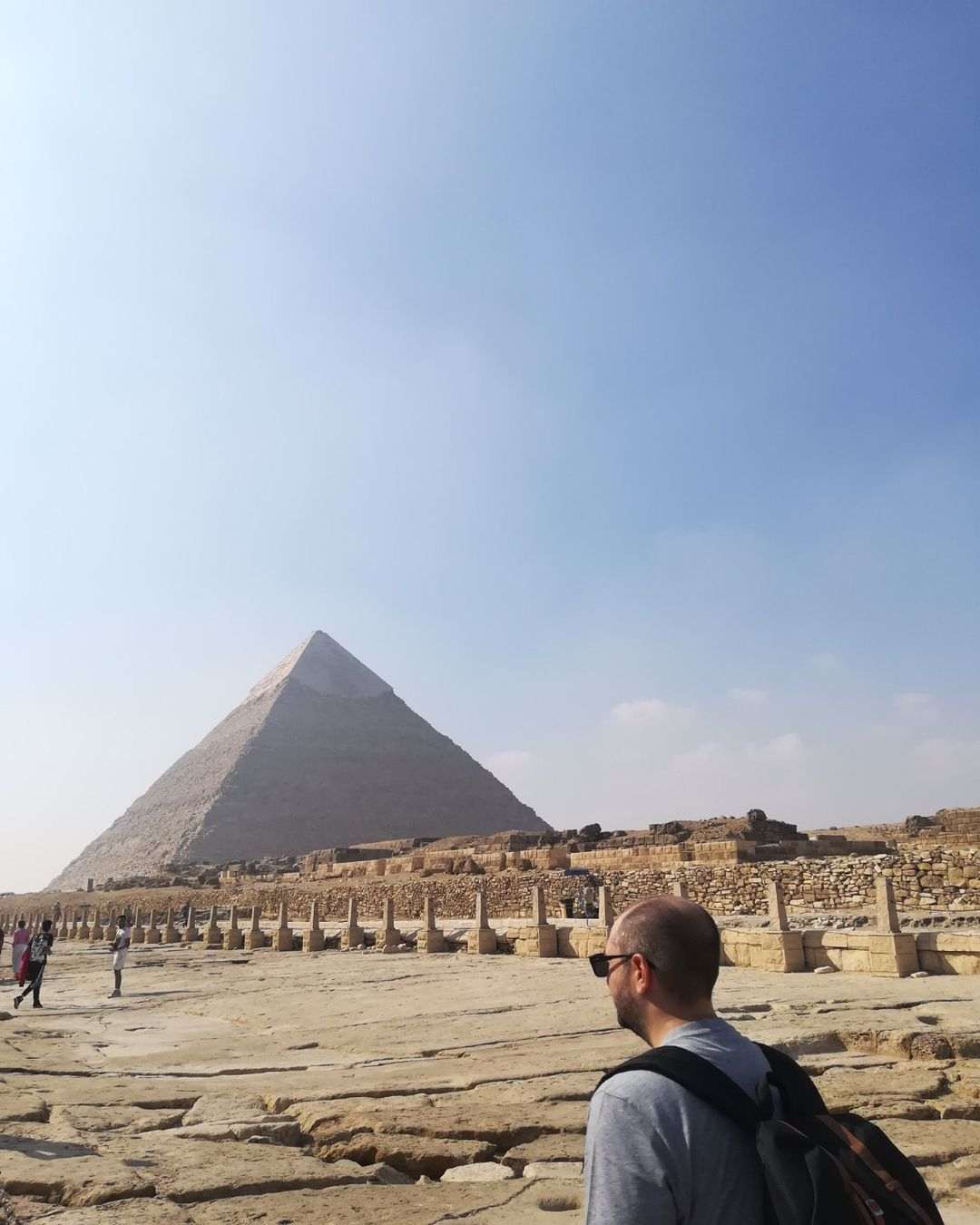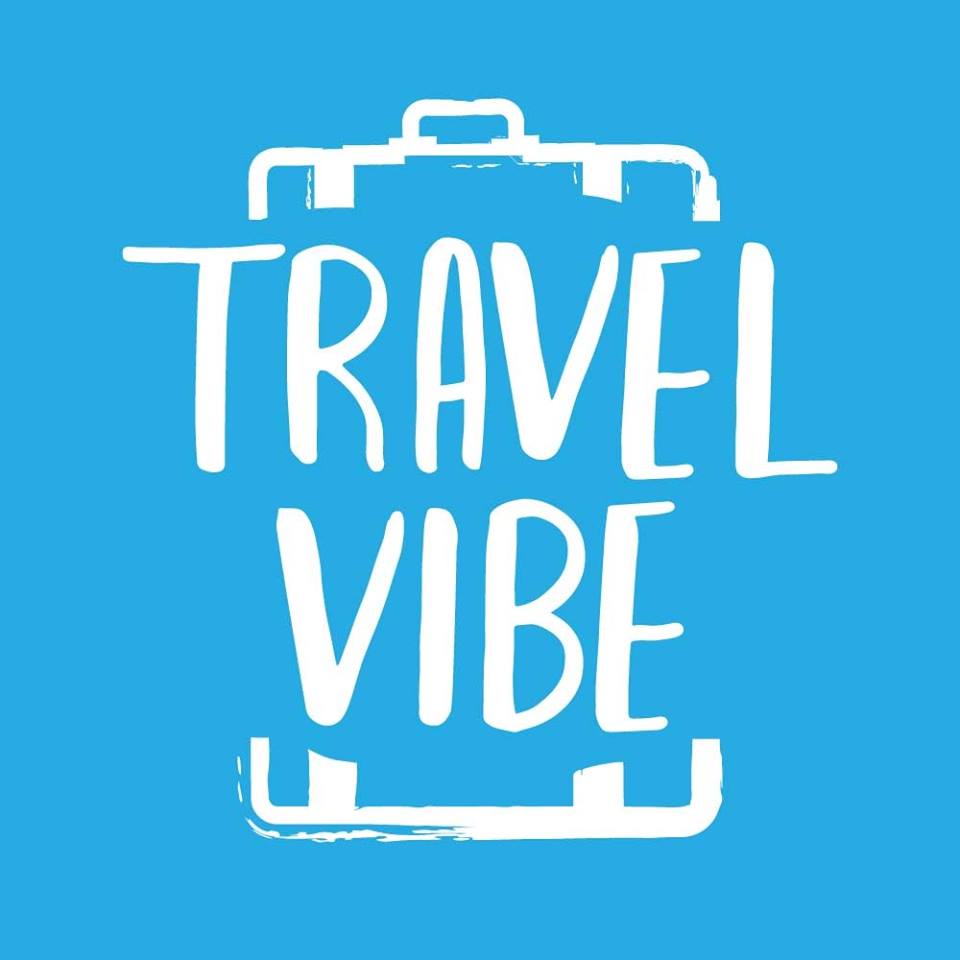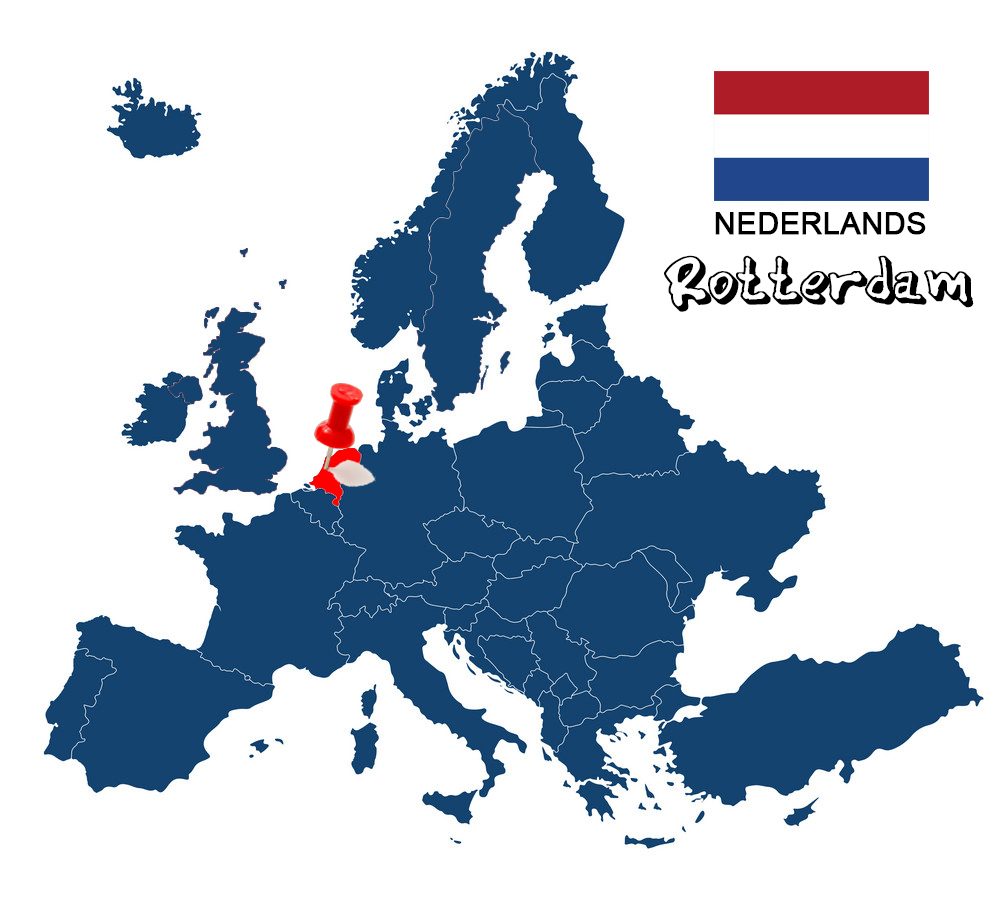
Let's not hide behind our finger; we have all associated a trip to Holland with picturesque canals, windmills, tulips and an attractive freedom. So delete all this and you will have Rotterdam. A city different from the rest of the Netherlands, extremely modern, rich in innovation and inspiration, with subversive architecture, intense “urban” culture and awesome natural beauty.
A few words about the city
Rotterdam is the second largest city in the Netherlands after the capital Amsterdam, both in area (319.35 km2) and with a population of 616,528 and 1.3 million inhabitants in the wider metropolitan area. The port of the city is the biggest in Europe, while until recently it was the largest in the world and is located on the banks of the river Nieuwe Maas. The name Rotterdam comes from the merging of the names Rotte (r) + dam, meaning a dam on a small river, the Rotte, which contributes to Niue Maas in the heart of the town. Rotterdam “flourished” in the late 19th and early 20th centuries, but this growth was abruptly interrupted by the bombardments of World War II. Reconstruction projects, however, turned Rotterdam into a modern city, with a unique architecture that has nothing to do with the rest of the country. The locals used to say jokingly that "the money goes out to Rotterdam, are distributed in Hague and wasted in Amsterdam". Almost half of the city's inhabitants are immigrants, mainly from North Africa and the former Dutch colonies, who came to the big port in search of a better future and are the ones who give it a different "note" compared to the native Dutch. Rotterdam, apart from the port, is also world-renowned for Erasmus University and its high-end modern architecture. So I will try to introduce you to the Grand Harbor through my own eyes and share with you what I think someone who is visiting for the first time should see.
Centraal Station
Arriving in the city centre, you will find yourself facing Rotterdam Central Station. This is a special-modern construction, completed only in February 2014. The station is known as "the international gateway to Rotterdam", while it is the only Central Station in the Netherlands that has a plain Centraal without the name of the city, since it is said that when you are at the Rotterdam Station, you just recognize it! Its roof is partially covered by solar panels, and many elements from the old railway station that stood in the same place have been preserved, such as the original clock on the facade, the letters describing the Centraal Station (now in LED lights) and the "speculaasjes", the granite sculptures on Platform 1.
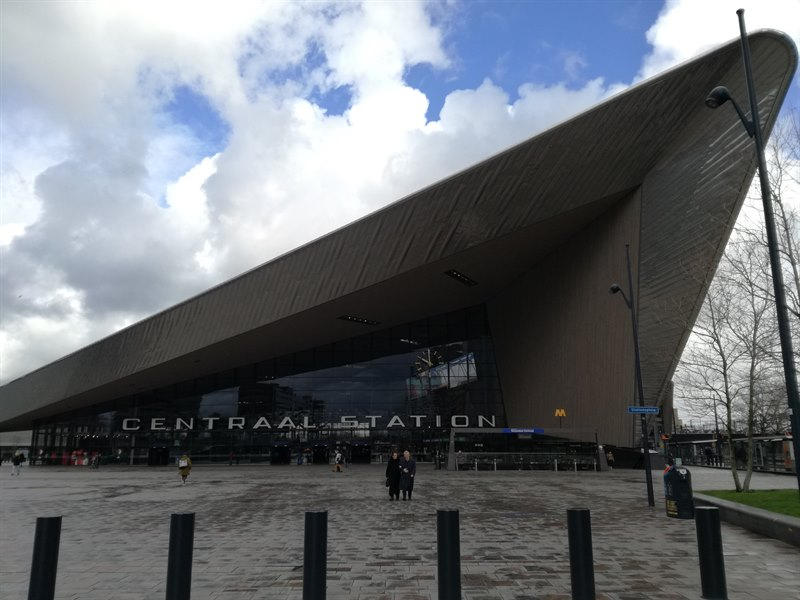
Markthal
The Covered Market Markthal is one of Rotterdam's most ambitious architectural projects and is certainly among the most fascinating sights of the city. It is a huge horseshoe-shaped building, operating since 2014. The walls inside the building are decorated by the colorful digital mural of the Dutch artist Arno Coenen in collaboration with experts in digital effects, which many call the "Sistine Chapel of Rotterdam"! It depicts grocery products that can be bought in the market, while flowers and insects refer to the still life works of Dutch artists from the 17th century. Giant glass walls protect the market from cold and wet weather, while interesting is the fact that Markthal is habitable and if you are observant you may see a tenant through the glass windows inside the market. Indoors you can find a huge selection of domestic products, such as chocolates and cheeses, as well as various restaurants, cafes and other retail outlets.
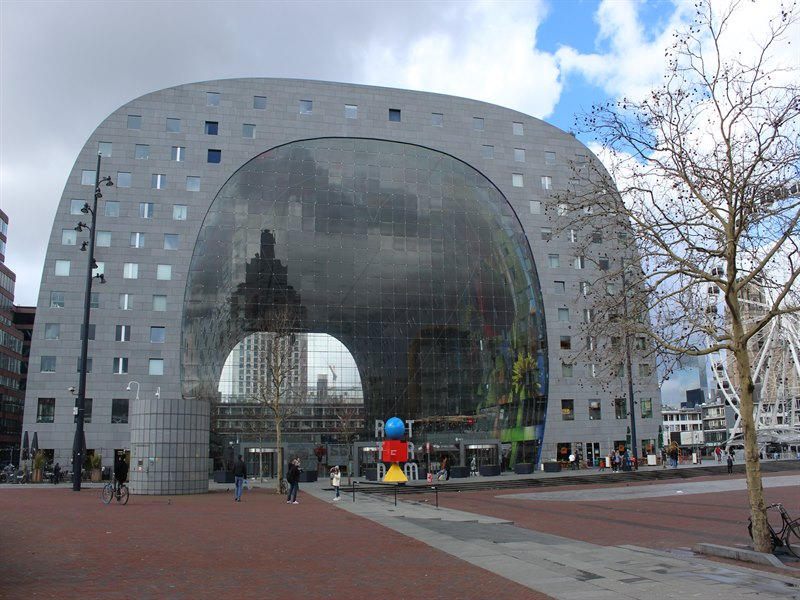
Laurenskerk
Rotterdam may today be a centre of avant-garde architecture, but it does not lack history. The large Church of St. Lawrence (Laurenskerk) is perhaps the only reminder of the city's historical past among the many high-rise and modern buildings. It is a Protestant church, built in 1449-1525 in a late Gothic style, being the only medieval ornament of the city. During World War II and more specifically during the surprise attack on Rotterdam (Rotterdam Blitz) on 14 May 1940, it was badly damaged by bombing. The damage was almost irreparable, with the original decision talking about demolishing the church, but the whole plan was stopped by Queen Wilhelmina of Holland. In 1952, Queen Juliana of the Netherlands laid the foundation stone for the restoration, and thus the reconstruction was completed in 1968. Today the imposing Church of St. Lawrence stands proudly in the most central part of the city, being a pole of attraction of believers, but also tourists from all over the world.
Kijk kubus
The Cubic Houses (Kijk kubus) are located in the city centre, directly opposite Markthal and are one of Rotterdam's most famous attractions. The idea for the construction of Cubic Houses was born in the 70s by the designer Piet Blom, who managed to implement it in 1984. The philosophy was to create an urban housing, with a high density of housing that would have sufficient space on the ground floor. Blom tried to represent a forest using each cube as a tree, so that the cubic village would create the entity of the forest. All cubic residences were built in the same way and divided into three levels: a triangular space on the lower level like a living room or kitchen, bedrooms and bathrooms on the middle level and a living room or bedrooms on the latter. The architectural design of the houses aroused the interest of many tourists, who wanted to see them up close, but the residents began to get annoyed and argue that their privacy was encroached on. As a result one of the owners decided to open for the public a furnished house, offering tours to guests. Entrance costs 2.5e.
Haven van Rotterdam
The port of Rotterdam (Haven van Rotterdam) is the most significant port in Europe, as it serves as a gateway for transatlantic and not only goods to this continent. Located on the banks of the river Nieuwe Maas, it is in itself an attraction for the city of Rotterdam. Since 2004, Asian ports such as Singapore and Shanghai have deprived it of the world title he held until then.
Formerly, the construction of bridges at Rotterdam was avoided, because there was great difficulty in the passage of ships. Later, however, with the development of technology, the gradual construction of such projects began, first with the Queen's Bridge (de Koninginnebrug), in the homonymous part of the Port (de Koningshaven), in 1870. The first notable bridge connecting the two banks of the Nieuwe Maas, was the old William Bridge (de oude Willemsbrug) in 1878, and for a century, there was no other bridge over the river, to the west of it. As an extension of Willemsbrug, just east of Koninginnebrug, the Hef Bridge (De Hef) was built in 1878, which, due to the railway line passing through it, was reconstructed in the 20s. Other major bridges are: the North Van Brinen Bridge (de Van Brienenoordbrug), opened in 1964 and expanded in 1990, The New William Bridge (de nieuwe Willemsbrug), opened in 1991 east of the old one, which was also closed and the impressive Erasmus Bridge (de Erasmusbrug), opened in 1996 and has the nickname "The Swan (De Zwaan)". The last one is the biggest and heaviest in Western Europe and has the largest panel of its kind in the world. It cost 165 million Euros and was named after Desiderius Erasmus, a prominent Christian Renaissance humanist, also known as Erasmus of Rotterdam.
In the port area you will also find Vlaggenparade. It is essentially an open-air museum, displaying 230 flags side by side along the Nieuwe Maas River. The flags are there in order to welcome the 193 nationalities who live or explore the city, while at night they are lit, creating a unique spectacle.
Kop van Zuid
Crossing the Erasmusbrug Bridge, you will find yourself in one of the city's newest built neighborhoods, Kop van Zuid. There you will understand why Rotterdam is considered one of the favorite cities of architects, since the most famous "stars" of the industry have left their mark on the region. Kop van Zuid is built in old, abandoned port areas and for many years was a "ghetto", until the decision makers decided to redevelop the area, in order to unite the northern and southern part of the town.
On that point you will observe some of the most important buildings of Rotterdam, such as that of Rem Koolhaas, which consists of three skyscrapers about 150 meters high each, forming a "vertical city " of high quality apartments, a 4-star hotel, offices, shops, restaurants, gym and parking spaces. Also, you will admire the impressive World Port Centre, a 33-storey and 123-meter skyscraper, and Montevideo, a 43-storey and 140-meter skyscraper. At the edge of the pier dominates the legendary Hotel New York, which was the headquarters of Holland America Lines and from there began the first commercial trip to America!
Finally, in Kop Van Zuid you will have the opportunity to see a forest in the water! This is an idea of the artist Jorge Bakker, who is known worldwide for his sculptures and subversive installations. The floating forest (Dobberend Bos) consists of 20 miniature trees floating on the water, raising questions about the relationship between the city dweller and nature. On the pier there is the 21st tree, therefore give visitors a more proper look at the whole venture.
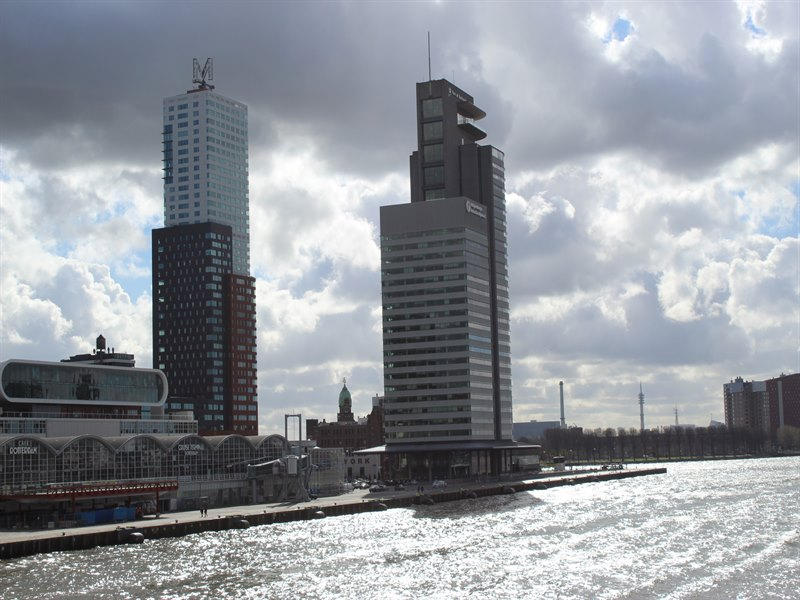
Euromast
If you are looking for the best view of the city, then the choice is one and it is called Euromast. It is a concrete mast-shaped observation tower reminiscent of a ship mast, designed by Hugh Maaskant and built between 1958 and 1960. It was constructed for Floriade (a flower and garden exhibition held every decade in the Netherlands), but its popularity was so great that it is now an attraction in itself. Initially, at 101 meters, it was the tallest building in Rotterdam, a "title" it lost when the 113.5-meter-high "Erasmus MC" building was completed, which was completed in 1968. However, it regained the title of tallest building in 1970, when the "space tower" was built on top of it, giving it an extra height of 85 meters. The total height of today, measured and the antenna at the top, is 184.6 meters, while the height of the roof is 104 meters. You can visit the observation deck at a height of 96 meters with 10.25e and if you are lucky and the horizon is clear, you can see Hague and Antwerp, as well as dine at the restaurant located on the same level.
Pauluskerk
The Church of St. Paul (Pauluskerk) is not a typical church, since it differs from all the classical temples that we have in mind. It is a modern architectural approach of the British architect William Alsop just in 2013, to replace the homonymous temple that stood in the same place. The original temple was built in the late 1950s and was particularly famous because it was a sanctuary for the homeless, asylum seekers and drug addicts. The close proximity of the temple to Rotterdam Central Station and the controversy surrounding its mission, have slowly but surely led to a collision course with the renewal and reconstruction of the station area. So in 2007 the original church was demolished, and the construction of a new temple building under the CalypSO project began. Today the Church of St. Paul is open to visitors and tries to reach the faithful in a more "modern" way.
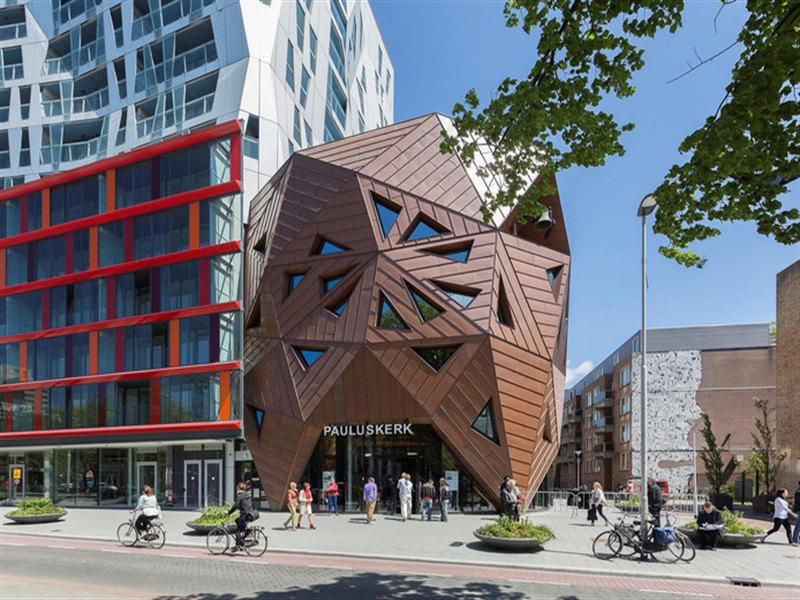
Beeldenroute Westersingel
Along the Westersingel canal, which stretches between Chinatown and the Museumkwartier, there is the Beeldenroute Westersingel (ie the sculpture path of the Westersingel canal). This is a beautiful walk through the city center with trees, benches and various works of art from the Rotterdam International Sculpture Collection. At this point there are 17 works of great sculpture such as Rodin, Carel Visser, Joel Shapiro and Umberto Mastroianni.
But the most famous of the sculptures is a Santa Claus (known as Kabouter Buttplug), created by the American Paul McCarthy. According to the creator, the image represents Santa Claus holding a Christmas tree in his hands, but people did not see what the sculptor wanted and the sexual comments soon became apparent. Despite all the reactions, the statue stands haughtily at the end of the Beeldenroute Westersingel and it is even said that if you rub its foot, it will bring you good luck!
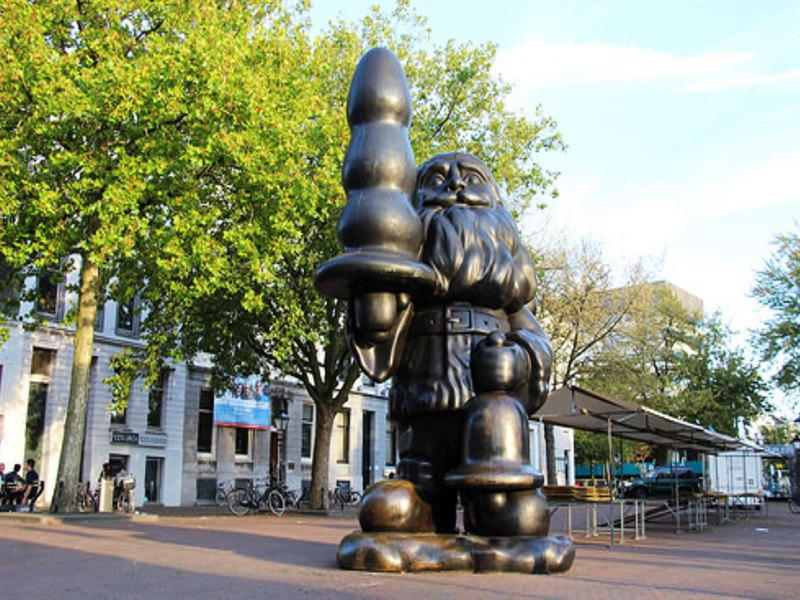
Museumpark
Museumpark is what its name indicates, namely the Museum Park. It is a beautiful spot in the city center, which brings together all the art spaces of Rotterdam.
The most popular museum in the city is the Boijmans van Beuningen. It is a museum that opened in 1849 and houses the collections of Franz Jacob van Boimans (1767 - 1847) and Daniil Heorhe Van Beuningen (1877 - 1955). The collection, which extends from medieval to contemporary art, includes, among many others (about 140,000), masterpieces by Rembrandt, Claude Monet, Vincent Van Gogh and Salvador Dali. Admission costs 17.5e.
At the same place you will find the Kunsthal Museum of Contemporary Art, known for its most "progressive" character. Kunsthal does not have a permanent collection, but hosts more than 25 exhibitions of contemporary art, fashion, photography and design each year. The range of exhibitions presented in the museum ranges from artists mainly of the 20th century, but also from contemporary art movements. Recently, the museum had exhibitions with artists such as Chuck Close, Andy Warhol and Arne Quinze. Admission costs 14e.
Finally, you should not miss the impressive white villa, which houses the Chabot Museum. In this special building you will have the opportunity to admire works by the Dutch expressionist Henk Chabot from the 1920s to World War II. Admission costs 8e.
How to go
Unfortunately, there are no direct flights from Thessaloniki to Rotterdam, so your options are two. The first is to get to the city through an intermediate combined flight by air. The best option is a flight to Girona with Ryanair and from there fly by Transavia to Rotterdam, where with proper planning one can find tickets from 212€ round trip. Also, it is easier and more economical to fly to Amsterdam via Transavia (106€ round trip) and from there take a train or bus, which costs about 15€ round trip.
Where to stay
Rotterdam is a big metropolis and has nothing to do with other Dutch cities, which makes it particularly attractive to tourists. I would suggest you find something in the center, as the distances are relatively long and you will lose time and money if you step outside. So my suggestion is citizenM Rotterdam, a 4 star hotel, with spacious rooms and helpful staff, located next to the Cubic Houses.
How to move
Rotterdam has an excellent transportation system with metro, trams, buses and ferries covering all the lengths and widths of the city. However, traveling by public transport to Rotterdam it is an expensive and complicated procedure, which is in no way advantageous to buy individual tickets for each movement. So I suggest you purchase a card for specific times or days depending on your needs. Of course, like any self-respecting Dutch city, the bike is used quite a lot, as well as the roads but also the cycling literacy of the locals allows it. Finally, as far as taxis you can find them either on the road or call them by phone, but they are expensive and rarely used.
What to eat
Dutch cuisine is not something special and as a country the Netherlands is not famous for specific products, with the exception of course of cheeses (see Gouda) and potatoes. Locals when they go out prefer international cuisines, and if you want to get a picture of them, I suggest visiting Foodhallen, recently opened as a "branch" of what exists in Amsterdam. It is a hall with several shops, offering flavors from all over the world. The most gourmet hotspot of the urban area, where you will be able to have an "authentic" Dutch culinary experience is Fenix Food Factory. Located in the Katendrecht area in a renovated warehouse, it is the favorite hangout of the city's hipsters and so-called "Yuccies". Another good choice for fast food is Markthal, where you will find everything you want. Finally, I would suggest walking the Witte de Withstraat, a street full of beautiful bars and quality restaurants in the city centre.
Useful information

In Rotterdam we travel with a passport or a new type of Police ID, where the details are indicated in Latin characters.
In Rotterdam the language used is Dutch. The majority though, if not all, speaks English (and German), so ask for clarification in English.
The currency of the country is the euro.
Rotterdam is an hour behind Greece (GMT +2).
Getting to and from Rotterdam airport is simple, since there is a bus route (number 33) that will take you to the Central Station of the city.
The Greek Embassy in the Netherlands is located in The Hague and more specifically at 1 amaliastraat Street and its phone is +3170 3638700.
You should know that in the Netherlands light drugs, such as cannabis and marijuana, as well as prostitution are legal, are certainly not as "liberated" as Amsterdam, but they exist in many places in the city.
The best time to visit the city is the end of spring and the beginning of summer or autumn. Due to the Niue Maas River, there is enough moisture and the weather is often rainy, which will make your life difficult since the whole beauty of the town is in its port.
Recommended excursions → Amsterdam, Utrecht, Hague

If this article seemed interesting or contributed to your quality information, then you can like my facebook page: o_thessalonikios or follow me on instagram!
Mouzakidis Pantelis






